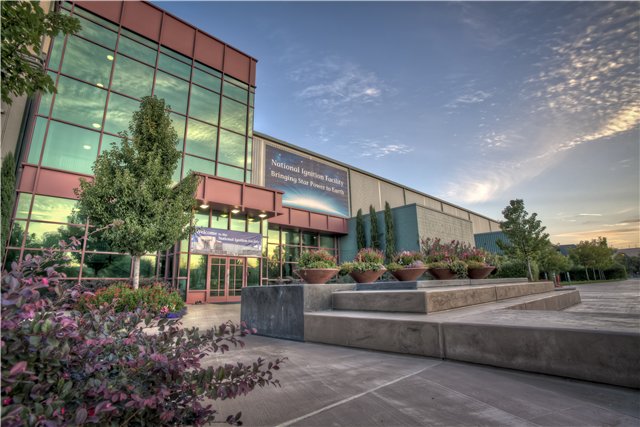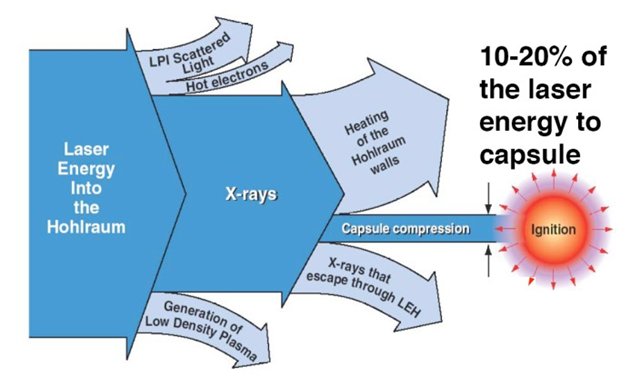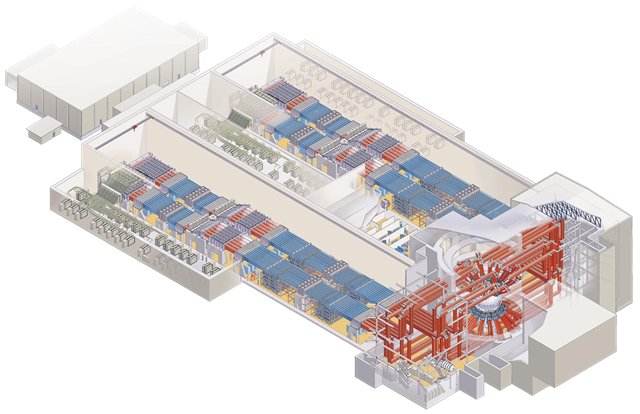Laser thermonuclear fusion: history
Start
(be careful, pictures!)
In the distant 1997 in Livermore (California), construction began on the NIF-National Ignition Facility complex, which is also the national ignition complex. The purpose of this huge complex is the study and implementation of ICF - inertial controlled (thermonuclear) synthesis. The key difference of this type of synthesis from others is that thermonuclear fuel retains itself due to inertia. (remember, in the tokamak, which is going to be launched in 2019 in France, the plasma is held by a magnetic field) The process should proceed as follows: the target (fuel ball, more about it later) is heated to a temperature that allows the synthesis to pass before the plasma scatters in different directions, that is, the reaction is pulsing.
In NIF, this problem was approached as follows: small, just two millimeters in diameter, a ball of fuel is heated by a laser beam, receiving a huge amount of energy in a matter of moments, which means the fuel will have time to heat up and react without flying apart in different directions in the form of a plasma. Moreover, the scattering of the fuel particles holds the inertia force. But not everything is so simple. NIF is designed for the implementation of indirect synthesis: the laser does not heat the fuel ball itself, but the hohlraum , a resonator that reflects the rays into the fuel, and it directs the rays more symmetrically than just a laser beam directed at the target. The fuel sphere itself consists of a thin beryllium shell, which contains solid deuterium-tritium fuel, cooled 18K (-255 centigrade).
Initially, the target shell was polymeric (polystyrene), but then the manufacturing technology changed: beryllium was sprayed onto the plastic layer, after which the plastic was removed, leaving only the beryllium layer. Due to this improvement, the energy directed towards the center of the explosion target increases.
Fuel Ball:

')
Gold resonator:

Process
Experiments are carried out according to this scheme: the laser emits a beam of 3 megajoules in the infrared spectrum. Of these, only one and a half go into the ultraviolet spectrum, of these one and a half, only 85% go into X-rays and about 15% (150 kilojoules) will be absorbed by the outer layers of the target, reflecting from the gilded resonator. The outer layers of the target will evaporate, creating jet thrust directed toward the center, which will create additional pressure. The reaction starts in the center of the target and spreads to its outer layers, after which the target will acquire a density of 1000 g / cm3 (about a hundred times higher than the density of lead), which results in the release of about 20 megajoules of energy as a result of synthesis. Improvements of the resonator and the laser itself should increase the absorbed energy to 420 kilojoules, and the resulting output to 100-150 MJ, but the design of the complex does not allow to get more than 45 MJ at the output.
Energy loss on the way to the target

Giant
Recently, on July 17, NIF scientists tested the most powerful laser in the world. Installation broke all records: the power of the UV laser is 500 terawatts. The laser releases 192 beams at the target. The duration of each pulse is about a nanosecond, and the difference between the first and the last is no more than 30 picoseconds, the Goal receives 1.85 MJ of energy. The temperature in the center of the target reaches one hundred million degrees Celsius. Such a laser makes energy-efficient synthesis available. Perhaps the fruits of this discovery we will reap before 2040, when it is planned to receive energy from ITER being built in France.
Getting energy
One of the problems faced by researchers is the generation of energy from the reaction. So far, it is planned to divert thermal energy and convert it into electricity. With a sufficiently large frequency of “explosions”, the walls of the chamber will heat up, and after that the case will remain small. However, the installation can not take more than one shot at 5 o'clock due to the strong heating of the optical system, therefore for the industrial production of energy it is necessary to improve the cooling system.
The history of the complex
Work on the NIF began with a Beamlet beam demonstration in 1994, after which, in June 1997, preparations began for the construction of the complex. Its cost was estimated at 1.1 billion dollars and another billion was required for research. The complex was supposed to be ready by 2002. However, the same year, the date was shifted to 2004, and the company was allocated another hundred million dollars. In December 1997, construction was suspended, because on the site they found mammoth bones with an age of 16 thousand years.
In 2000, it was recognized that the company went beyond the budget, and according to new estimates, it required 3.9 billion dollars, the deadline for construction was shifted to 2006. However, construction continued under the new leadership, the experiments began in 2005, and on May 29, 2009, a solemn opening ceremony was held, attended by the Governor of California, Arnold Schwarzenegger. Already at the end of June 2009, the first experiments began with a view to the golden resonator.
Scheme of the complex:

Panorama of the complex
So, I look forward to the start of thermonuclear fusion, which should give us cheap (and in the depths of my soul I hope that free energy).
In my opinion, the course of experiments looks very promising, despite some difficulties. But in any case, time will tell.
UPD 06/02/2014 : ilya42 asked to move the article to the hubs "Physics" and "Energy and Batteries", which I do.
Unfortunately, due to lack of time, I can hardly modify it according to the wishes of the commentators, as I wanted earlier.
Source: https://habr.com/ru/post/150175/
All Articles